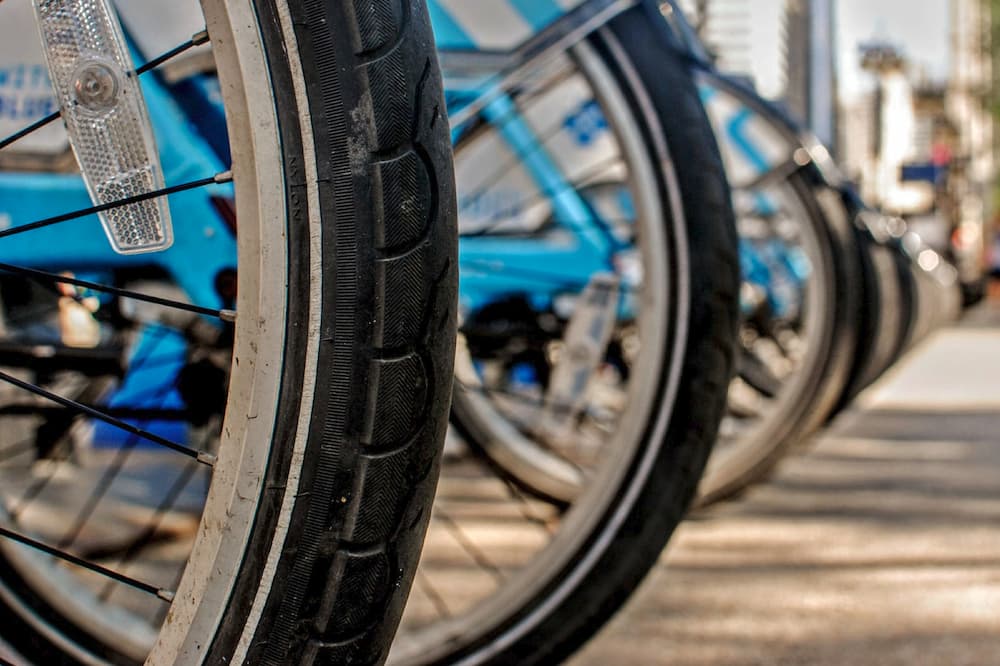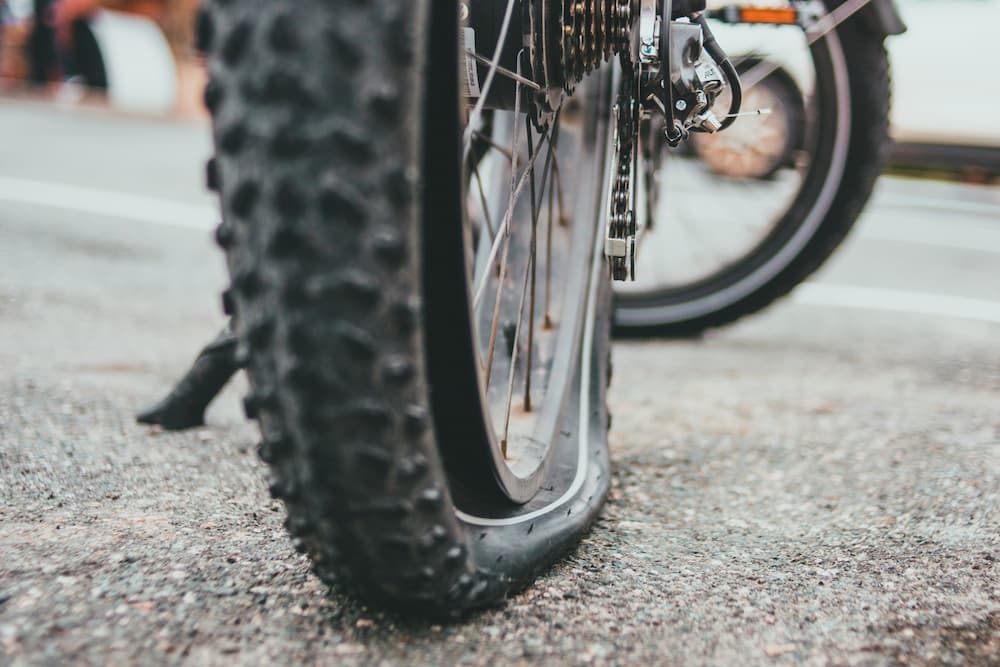How To Inflate A Bike Tire Without A Pump?
Nothing is more frustrating than when you go out on a stroll with your bicycle, and a loose rock causes your tire to puncture. You are far away from your garage and left your pump at home. You start to panic and look for options on the internet. Lucky you that you stumbled upon our article.
In this writing, we will discuss the several ways you could inflate your bike tire without a pump to avoid falling into such a situation. So, park your cycle, sit down on the side and dive deep as we go through the ways to inflate your bike tire without a pump.
As an Amazon Associate, I earn from qualifying purchases made through links in this post at no extra cost to you.
Contents
Can you Inflate A Bike Tire Without A Pump?

Inflating a bike tire without a pump? Sounds crazy, doesn’t it? Luckily, some ingenious cyclists and mechanics have found ways to inflate a bike tire without a pump through experimentation and experience.
In the following sections, we’ll go into detail about these methods. We’ll also go over the prerequisites and the pros and cons of each method so you can choose the one that’s right for you!
How Can You Inflate A Bike Tire Without A Pump?
In the following sections, we’ll take a look at seven different methods by which you can inflate a bike tire without the use of a pump. So, let’s get right to it.
Method 1 – CO2 Inflator
If you are considerate, you should carry a CO2 gas canister. This little canister will be your lifesaver.
Using a CO2 canister is the next best alternative to using your pump to inflate your tire. It is feasible as it is lightweight, minuscule, and portable.
You might wonder, although you have a canister, you do not know how to use it. Well, that is why you are still reading this article. We will shortly give you a step-by-step guide.
Things To Keep In Mind
There are various sizes of gas canisters available in the market. A 25-gram cartridge is enough to inflate both tires of your bike.
Although it seems straightforward, using a CO2 cartridge to fill your bike tire is a temporary solution. As CO2 disappears quickly, you must fill up your tire with ordinary air as soon as possible.
Steps to Using a CO2 Cartridge
Now, let’s take a few simple steps to use a CO2 cartridge.
Related reading: Can I Use a Car Tire Pump on My Bike?
Step 1
The first step is to remove the cartridge cap. You do this by turning the cap clockwise and retrieving the inflator fitting and the cartridge by pushing upwards from the other side.
Step 2
The next step is to check whether the tire is in position. In most cases, the tire gets displaced after it deflates. Position the tire back in the rim so that the tire can inflate adequately.
Step 3
Attach the CO2 cartridge to the inflator fitting and push it up with one hand. It ensures a good fit. Turn the cartridge clockwise to release the compressed gas.
Step 4
Keep the cartridge in place till the tire is fully inflated. Check from time to time whether the tire is completely inflated. After the tire reaches your optimum pressure, turn the cartridge anti-clockwise to stop the gas from releasing anymore.
Step 5
After you are done, unscrew the CO2 cartridge and place back the valve cap on the valve to seal the air in.
What is required:
- CO2 inflator cartridge
- A suitable chuck
Method 2 – Siphon hose
If you have a flat tire, you can always ask for help from a passerby vehicle, biker, or cyclist. As long as you have the correct hose for siphoning some air to your bike’s flat tire, you can use this method.
First, ask if the other person has a tire pump, as a pump will solve your problem very easily and quickly. If the other person doesn’t, you can ask if you could siphon some air from one of the tires of their vehicle.
If they agree, take out your siphon hose with Schrader barbs on each end. One of the ends needs a clip, so you may close the hose to save some gas.
Connect your flat tire to one of the tires from the person you’re taking gas from and open the tire clip. Take as much gas as you need to get to your home or nearby pump.
If it’s another cyclist you’re borrowing from, take only a bit from them, and fill the rest up from your other tire. It will help you equalize the tire pressures without jeopardizing the other person’s ride.
What is required:
- A Siphon hose
- A pair of Schrader barbs

Method 3 – Engine Combustion
While this isn’t an easy method, it can help you if you’re in danger. The air released during the compression of a motorbike engine can help you inflate your tire. So, for this to work, you need help from a passerby motorbike owner.
Ask the owner if you can use the exhaust gas from their engine to pump your tire or tires. If they agree, take out a compression tester and attach it to the engine.
Remove the tester and connect an extension cable on that end. The other end of that cable should have a Schrader barb that can be attached to your cycle’s tire.
Keep starting the bike repeatedly until the tire comes under pressure. It will take some time and footwork, but it’s a handy method for getting out of trouble.
What is required:
- A hose
- Schrader barb
Method 4 – Expansion By Combustion
There’s also this crazy technique that many claims inflates bike tires. In this technique, you literally need to burn your tire.
To start off, you need to spray some contact cleaner under the bead of the tires using a needle nozzle. Also, spray some on the rim to make sure the fire enters inside.
Now, once it starts burning, the fire will expand some of the air insides. However, that’ll only remain inflated as long as the fire is burning.
Here, the trick is to keep the valve open while the fire burns. When you’re burning a contact cleaner, you’re essentially burning a hydrocarbon in presence of oxygen. This leads to the creation of water and carbon dioxide.
From one of the previous methods, we saw how carbon di-oxide can inflate the tire of your bike. Now, if you keep the valve open while burning the hydrocarbon, it’ll suck in more oxygen, thus creating additional carbon-di-oxide.
In this way, you can inflate your bike’s tire to a certain degree. However, it does come with some potential dangers. One of the greatest risks of this method would be the tire blowing up. You can easily prevent this by lighting it up from a distance.
What is required:
- Any contact cleaner
- Needle Nozzle
- Lighter
Method 5 – Dry Ice
This method works a lot like CO2, but it’s a bit more inconvenient to travel with dry ice. Nonetheless, we’ll discuss the procedure in detail.
Dry ice can create a ton of gas. Only 1.5 ml of dry ice can create up to a liter of gas. So, to inflate your bike’s tire with dry ice, you need to open the valve core first. Once it’s open, stuff some dry ice down the opening.
Keep in mind that dry ice can damage the rubber of your tire. If any part of the rubber gets frozen, that part will become brittle and may potentially break. So, we recommend rotating the tire so the ice block keeps moving around.
What is required:
- Dry ice as per necessity
Method 6 – Spray Duster or Pressurised Gas
You can also use any pressurized gas canister for inflating your bike’s tire. This is a rather simple method that requires the gas canister itself, along with some simple tools.
Firstly, take out the core valve. Here, you must know that if you have a quality airtight valve cap, you’d be better off leaving the valve core the way it is.
Now, take a spray duster or a pressurized gas canister. Install a needle nozzle on it. Then, use some duct tape to attach the nozzle tightly to the valve. Here, you need to ensure that there isn’t any space remaining through which the gas may leak.
All that’s left for you is to spray away until the tire is inflated enough to help you limp back home.
We’d recommend inflating the tire a bit more than you’d like. This is because, once you take off the makeshift adapter made of duct tape, some air is bound to leak no matter how fast you put the valve in.
What is required:
- Spray duster or any pressurized gas canister
- Duct tape
Method 7 – Use your mouth
Can you really pump the bicycle tire with your mouth? Yes, you can. Although it may seem like it is not possible, blowing up your tire with your mouth is a genuine option. Especially when you do not have many tools in hand, it does require a lot of work and time, so buckle up.
Before you start putting your lungs to work, ensure you maintain hygiene. The tire’s valve is not the cleanest object out there as it is constantly subject to mud, dirt, and dust.
Wipe the valve with a towel, tissue paper, or your t-shirt to remove any surface dirt. After you ensure the valve is cleaner, it is time to get your hands dirty.
Start by blowing in small amounts of air at a time. To keep the valve open, place your tongue on it and apply pressure.
After inflating the tire a bit, stop to check whether the tire falls perfectly on the rim and adjust it in place if it is not already.
This process is laborious and time-consuming, so we need you to be patient. Don’t get discouraged or demotivated, as this little task will take you a long way (no pun intended).
What is required:
- A towel or a tissue paper
- A lot of time
Related reading: How To Deflate A Bike Tire?
Conclusion
Accidents can happen and your bicycle tire being punctured is one of them. It is alright if you do not have your air pump with you, as there are more ways to inflate a bike tire without a pump.
When using the manual method, make sure that you clean the valve properly before you place your mouth on it to maintain hygiene.
A more conventional and popular approach would be carrying a CO2 cartridge instead. They are pocket-sized and convenient to use if you know the steps and follow this guide. Make sure to replace the CO2 with regular air whenever you can, as CO2 dissipates faster.
Siphoning air from someone else’s vehicle can be a solid option when you don’t have any other choice. While you aren’t necessarily jeopardizing that person’s trip, not all will be eager to share their tire’s air with you.
In such cases, it’d be best to use combustion to inflate your tire. While this is a relatively lengthy process and takes some time, others may be more willing to help you without losing some of their tire pressure.
With the help of this article, you are now well-equipped to tackle a punctured bicycle tire, even if you don’t have a pump around.
